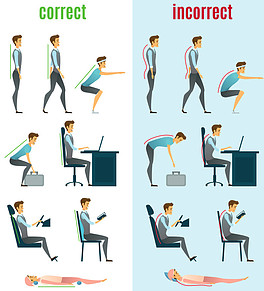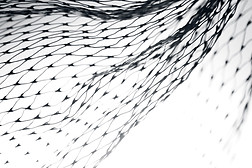Fascia, also called connective tissue, surrounds as well as supports each muscle fiber, tendon, nerve, blood vessel and bone, so that they stay in place. It is made up of microscopic collagen fibers shaped into tiny tubular structures, a protein called elastin, to create flexibility and oily goo called hyaluronan so the collagen structures move freely over bones. It is also innervated with fibroblasts that communicate with each other, creating a neural network responsive to many types of trauma or behaviors. They can also contract the tissue as well as weave it like tiny spiders. For a more technical article on fascia and chronic pain read here.
Why should I care about my fascia?
Fascia responds to a sedentary lifestyle and poor posture by thickening near the joints, and becoming sticky. When it dries up and tightens around muscles, it can limit mobility, cause pain and bundle into mounds of this rubbery tissue. If you are active, this is less of a problem. However, if you experience a trauma or injury, the same bundling occurs to protect the joints.
up and tightens around muscles, it can limit mobility, cause pain and bundle into mounds of this rubbery tissue. If you are active, this is less of a problem. However, if you experience a trauma or injury, the same bundling occurs to protect the joints.
80% of my work in clinic dealing with chronic pain origins in fascia bundling, This can affect posture, gait and alignment of hips, back or shoulders. This fascia is everywhere in your body! More than 20% of your body mass is fascia. Yet, most folks know very little about fascia. Carpenters know it as a flat material covering the ends of rafters, or molding as a superficial layer for decoration, to hide the joints and joists. This body fascia is also a covering, but it has critical functionality in the way we move. It is really a sensory organ that simultaneously observes and facilitates our movement and posture.
What can I do to improve fascia functionality?
Think of fascia as a kind of smart and flexible gummy clay that molds your body. Observe if you roll your shoulders forward, round your upper back and tilt your head forward to text, work on your computer or even drive. If you find that those body behaviors often happen throughout the day, your fascia is taking notes. Your fascia will respond by thickening and bundling to help support your most common positions, tasks and behaviors.
round your upper back and tilt your head forward to text, work on your computer or even drive. If you find that those body behaviors often happen throughout the day, your fascia is taking notes. Your fascia will respond by thickening and bundling to help support your most common positions, tasks and behaviors.
Regular movement of all the joints in many directions will help break up the holding patterns. Set an alarm for every hour if your work keeps you desk bound at a computer for long periods of time. Take a walk, move your arms, do some basic twists and turn your head in all directions. Don’t move too fast, move deliberately. Personally I use Qigong for these kinds of movements. Qigong gives an intentionally as well as breathing exercises to the slow, fluid movements needed for fascia reset. Here’s a video for one of my favorites. This is a Qigong not only to provide fascia reset, but also to teach your mind to manifest what you want for the rest of the day! Click Here for the Manifestation Qigong.
When you stretch, try not to stretch too far initially. If bundled, fascia will respond to a big, deep stretch by thickening even more. Start at the first edge of the stretch, just when you barely begin to feel the muscles starting to pull, and hold there for longer than you would normally hold your stretch. Even 2 minutes is not too long in these limited stretches. I like to call them lengthening rather than stretches. Think of yourself being longer than your physical body as you do these simple postures.
The “Weaver” of our body’s posture.
The weavers of our posture are the Fibroblasts of the fascia. These little miracle workers create much of this extracellular matrix, much like a collagen net that gives support and allows functionality to our muscles, tendons, bones and organs. Fibroblasts not only emit the tiny collagen fibrils that are actually microscopic tubes they are also great communicators. As a body part takes on weight, the Fibroblasts communicate to one another and can actually change location, providing additional support for the stressed area. When the tension is released they slowly return to their former positions, and the “net” of collagen fibers come back to form.
matrix, much like a collagen net that gives support and allows functionality to our muscles, tendons, bones and organs. Fibroblasts not only emit the tiny collagen fibrils that are actually microscopic tubes they are also great communicators. As a body part takes on weight, the Fibroblasts communicate to one another and can actually change location, providing additional support for the stressed area. When the tension is released they slowly return to their former positions, and the “net” of collagen fibers come back to form.
Researchers are just scratching the surface on everything the Fibroblast accomplishes, and in turn how fascia responds to traumas. There is some disagreement in the scientific community on how to even classify fascia. A Paper came out recently proposing that fascia is indeed it’s own organ, The Interstidium. This organ, if science decides it is indeed an organ, not only provides structure, and protection, but is also a system of fluid-filled membranes. It would also be the largest organ in the body.
We think we know a lot, yet we know very little.
Conclusion
I hope this gives a bit of insight on the inner workings of our bodies. I know it can be complex, but most of us know more about the car we drive than the body we inhabit as our personal vehicle for the duration of this life. We all want to thrive. Thriving is more than making a lot of money, traveling to exotic places and socialization. Our body is out vehicle for awakening. I encourage you to learn as much as you can about how it responds to your particular lifestyle.
Here’s to your optimum health!

Only recently I had a problem with my leg, actually, it was coming from my buttock and one night I couldn’t find a proper position.
In the morning I realized that it might be buttock nerves – they somehow got stuck, due to my poor psture behind the laptop
While doing research I came across the term fascia and wanted to learn more about it.
I had no idea about how complex the body is… how it can quickly respond to lifestyle – especially after the age of 40.
Stretching is something I am going to practice on a daily basis but I am also going to keep an eye on your YouTube channel as there are many great videos.
Thanks a lot
Thanks for taking the time to read abd comment, Michal.
Indeed, fascia bundling was most likely the issue with your glute muscle. Sitting is really hard on it. Take time each good to move abd stretch a little.
Thanks also for your interest in my YouTube channel. Please consider subscribing, so you’ll get notified when I post new videos.
Stay well and thrive!
Al
There is a quote that says: we spend half-life not carrying on our body, and the other half we do! I think that is totally true. Your post I great, because these days, we sit a lot, and back pain is so common. Even young people are getting back pain, which is not normal. Genetically, I have not so great lower back, but with fiscal activities, gym, and swimming, keeping my weight down, I’ve lost almost all my problems.
Thanks, Ivan, for taking the time to read and comment on this article.
Yes lower back pain has become almost epidemic. Good for you for taking care of yourself by exercising and maintaining a healthy weight. Add more light stretching and the rest of the back issues should subside.
Stay well and keep thriving!
Al
Hi
Good to know about precise details of Fascia. So many things we tend to forget even if we have active lifestyle. Keeping open mind and reading such articles makes us feel confident that we are aware of this. Muscle pain is common but behind that there are so many things going wrong and one of the factor is looking after Fascia functionality. Thanks for your research and taking time to share this. People like you help in a great way to the community.
Regards
Thanks for taking the time to read and comment on the article. Thanks also for your kind words.
Yes, moving and stay active are so very important. It’s easy to get caught in front of the screen for goes at a time.
Stay well and Thrive!
Al
I had never heard of the term fascia. But, I am one of those people who can never sit still and I am always doing something. Even while I am working on my computer, I am constantly getting up and doing things. I also go to the gym every day. I watched the video, I I do believe I do a lot of similar things at the gym. So my fascia is probably reset everyday if that is possible!
Thanks for taking the time to read and comment.
Sounds like you’re moving and that’s good. If you get any pain from your workouts, fascia can bundle from an imbalanced workout or stretching incorrectly, Keep that in mind.
Stay well and thrive!
Al
Hi Albert,
Fascia is an important part of our body because it provides stability and support to our joints, organs, and entire musculoskeletal system. It has a role in protecting muscles from injury by absorbing impact from repetitive motions or stress as well as the important role in supporting joints and providing stability to the body’s structures.
Does the strong excise hurt Fascia or enhance it health?
Have great weekend, Albert
Thanks for visiting my sure again, reading and commenting, Safia
Exercise, strong or gentle, is great for fascia. As long as you balance it with smart stretching and proper cool down. Fascia will bundle and thicken at the joint if the fibroblasts perceive trauma. That could be a forced rep that strains a muscle beyond it’s capacity. It can also be caused from overstretching.
So, exercise or great, we need it to be vital, “Move it or lose it!” But we also have to listen to our body and not over do it. Wellness is a marathon, not a sprint, we should never rush to the next set, or to our next appointment.
Stay well and Thrive!
Al
I now understand a small part of what fascia is. This “organ” is meant to be able to support us in virtually any aspect of our continued position during the course of our lifetime. What I did not know before is that we can change with time and practice how our fascia interacts with the rest of our body.
When we begin to exercise or use qigong, we are changing the way the fascia reacts to the stimuli we send it. By learning qigong we are helping our bodies to be more flexible and also better able to handle the stresses of the day. We need to focus on being in harmony with our body and our surroundings.
Jerry
Thanks for taking the time to read and comment, Jerry.
You stated that eloquently, and received the message of the blog clearly. I’m happy you resonated with it and hope that it was helpful to your continued health.
Stay well and keep thriving!
Al
Hi Albert
Thank you for another great post, Al! This is the first time I heard about Fascia. I agree with you that we know really little about our body which is one of the greatest assets we’ve got in life. Actually, the only thing that we really own? These days, I try to be more active throughout the day, and I will check out the video as well.
Thanks again,
Grace
Thanks, Grace, for taking the time to come back and comment on this article.
I’m happy to hear you’re trying to be more active throughout the day. “Move it or lose it,” is one of my favorite mantras..
Stay well and keep thriving!
Al
Thanks for the helpful description of fascia and how it’s such a big part of the makeup of our bodies. I had no idea! I have had issues with plantar fasciitis in the past and it seems that working to stay flexible with correct stretching/lengthening exercises could offer some relief (and hopefully prevention) for the painful episodes.
Thanks for reading and commenting, Aly.
Yes, lengthen that fascia and you’ll feel better!
Stay well and thrive!!
Al